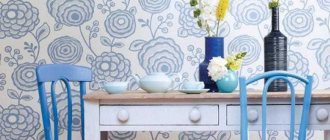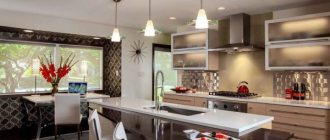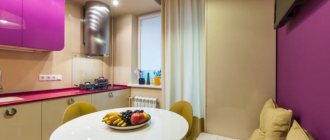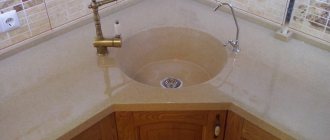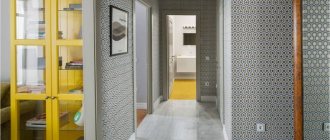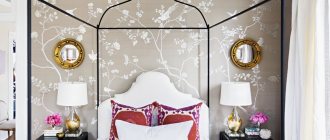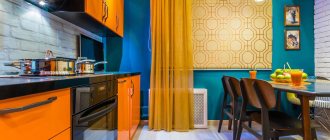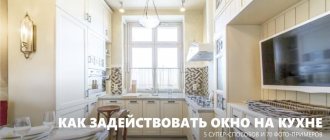When choosing wall coverings, many focus only on design and colors, but the main criterion that needs to be read is practicality. After all, it is in the kitchen that there is a high probability of splashes, variable humidity and an abundance of odors that tend to accumulate in finishing materials. Wallpaper used in such conditions must withstand wet cleaning with detergents, have good vapor barrier properties and have a durable color that will not lose its saturation throughout the entire period of operation.
Material selection
Let's imagine that you have already arrived at the store, and there are hundreds of different rolls. Wide and narrow, white and colored, with prints and monochrome. They are all different, and it’s difficult to understand right away what you want.
Let's start with the main thing. Before choosing a color scheme and width, you need to decide on the material.
There are several main types of wallpaper:
- paper;
- vinyl;
- non-woven;
- textile;
- fiberglass.
Each option is good in its own way. To understand what exactly you need, consider the characteristics of each type. And this is a small summary of the marking icons that you can find on wallpaper. This will be 100% useful to you.
Paper
The simplest, most common and budget finishing option. Ideal for any premises where it is important to update the interior and create an environmentally friendly atmosphere.
There are two types of paper wallpaper:
- Simplex - single-layer materials of low density and strength. They are thin and will not hide defects, so the walls must be thoroughly leveled before gluing.
- Duplex - two-layer coatings where layers of paper are glued to each other. Ornaments, prints or embossed patterns are applied to the front surface. Duplex is stronger and more durable than simplex, but costs more.
And now - about the pros and cons of paper wallpaper.
| pros | Minuses |
| Eco-friendly | Not suitable for wet areas |
| “Breathable” | Sensitive to mechanical damage (especially simplex) |
| Do not cause allergies | Fade quickly, fire hazard |
| Moisture and vapor permeable | Absorbs odors and fat |
| Budget | When gluing, problems arise (especially with simplex): the paper quickly gets wet and becomes unstable. This complicates the joining of the canvases and the adjustment of the pattern. |
| Large selection of colors, prints and patterns | Short-lived (simplex is replaced every 2-3 years, duplex - every 4-5 years) |
Note! Paper wallpaper is used where economical, quick repairs are needed. Or the environmental friendliness of the finish comes first. But, in any case, it is better to choose a duplex rather than buy a cheap simplex.
Vinyl
Vinyl is a popular wallpaper material for kitchen walls. The structure of vinyl sheets is multilayer. It consists of a paper or non-woven backing coated with a layer of vinyl (PVC) of a certain color, texture and density. According to the production method, external indicators and price, products are divided into three large groups:
- voluminous, with a beautiful and embossed decorative coating;
- super washable (recommended for kitchens!);
- silk-screened, with a beautiful pattern made of vinyl and silk threads.
| pros | Minuses |
| Embossed, dense and durable | “Breathe” worse than paper ones |
| Resistant to fading and abrasion | |
| Moisture resistant, can be wiped with a damp sponge | Poorly permeable to moisture and steam |
| Hides minor defects in wall decoration | |
| Large selection of colors and types | To do a good job of gluing, you need experience. |
| Will last at least 10-12 years | |
| With smooth walls and high-quality gluing, you will get a solid, seamless canvas | They are more expensive, especially in comparison with paper counterparts |
Vinyl coatings “breathe” less well and are less permeable to moisture and steam than paper ones. But do not be afraid that moisture and mold will accumulate under them. This can only happen in two cases. If:
- the apartment was flooded, and this happened during the cold season;
- a dark room with constant humidity and poor ventilation gets wet;
- The apartment is unheated, non-residential.
Note! The walls will become moldy if it was not possible to immediately ventilate and warm up the flooded home. In other cases there are no problems with vinyl trim.
Non-woven
Wallpapers from this line are safe and beautiful. Tear-resistant and abrasion-resistant. There are two main types:
- On a non-woven base, covered on the front side with a decorative layer of paper, vinyl, textile, or any other material;
- Non-woven on both sides. Moreover, the front layer is often textured and embossed.
| pros | Minuses |
| “Breathable”, moisture resistant; do not absorb dirt and dust; considered hypoallergenic | More expensive than paper counterparts |
| They can be washed or wiped with a damp cloth. | The convex, textured layer is easily damaged. |
| A thick layer of base hides minor defects and cracks in the walls. | Cheap options are of low quality and may contain toxic substances that are dangerous to humans. |
Non-woven materials are easy to work with. When gluing, glue is saved, because it is applied only to the wall. After drying, the material does not shrink. If glued correctly, seams and joints will not be visible.
Interesting fact! Non-woven wallpaper on a non-woven basis is the best choice if you want to change the decor of the kitchen, but not undertake a major renovation. After all, such coatings can be painted, changing color up to 8-10 times.
Textile
They are considered the most exquisite and decorative. They are expensive, but they also look expensive. After renovation they look like a luxurious carpet in the interior. The basis of finishing materials can be non-woven or paper. A layer of textiles is applied on top: linen, silk, viscose, threads of natural and synthetic origin. Or veneer, jute, seaweed, bamboo, cork, reed.
| pros | Minuses |
| Eco-friendly | Not suitable for the kitchen (!) |
| Pleasant to the touch | Narrow range of colors and textures |
| Exclusive, expensive looking | Short-lived, quickly fade in the sun |
| Holds heat well and protects from noise | To protect against dust, special impregnations are needed |
| Perfectly masks small cracks and uneven walls | They are expensive, and the work will cost a pretty penny, since gluing is more difficult (that’s why they are often used to finish one wall) |
Important point! Textile materials are difficult to care for. It is not recommended to remove dust and dirt with a wet cloth. It is best to collect it all with a long-bristled brush or vacuum cleaner. Wet cleaning is only permissible for coatings with water-repellent impregnations.
Glass wallpaper
Fiberglass, or fiberglass, wallpaper is made from glass fibers of different densities and thicknesses. The fibers are woven into fabric using the weaving method, and then impregnated with starch additives. Then the relief surface can be painted with latex or any other water-based paint.
| pros | Minuses |
| Eco-friendly | Narrow selection of colors and patterns |
| Strong, durable and moisture resistant | Porous, actively absorb paint when painted |
| Wear-resistant, does not absorb odors and fats | Once pasted, it will be very difficult to remove |
| Well masks uneven walls | You need to glue it on a perfectly flat plane, otherwise after drying the finishing material will become covered with cracks. |
Fiberglass is very durable, wear-resistant and reliable. This wallpaper is best suited for offices, banks, hospitals and hotels. But they can also be chosen for the kitchen. The surfaces will withstand up to 10-12 repaintings and last up to 28-30 years.
Important point! Fiberglass is considered practical and absolutely harmless. Designed for constant and active use. They are recognized as the most fireproof; upon contact with fire they do not release toxins.
By functionality
Washable
Main article: Washable wallpaper for the kitchen
This type of wallpaper is well suited for hanging in the kitchen. They are impervious to moisture and do not accumulate fat. Easy to wipe and clean with a damp cloth. The most popular types of washable wall coverings:
- Vinyl - smooth and textured. They are not afraid of water, burnout, abrasion, or mechanical damage.
- Non-woven fabrics are moisture resistant, do not fade, and are easy to clean with wet cleaning.
- Acrylic - multi-layered, soft and textured. They wash, but carefully, without using sponges, napkins or detergents.
- Fiberglass wallpaper - single-layer or double-layer. They can be wiped with napkins, sponges, hard brushes with detergents and abrasives.
For painting
- Wall coverings of this type can be repeatedly painted with latex or any other water-based paint. They will refresh the interior, and you won’t have to change anything radically. Types of wallpaper for painting:
- Two-layer paper with a water-repellent top layer. The packaging must be marked indicating that the products are moisture resistant and can be repainted.
- Non-woven, dense and wrinkle-resistant. Foamed vinyl is sprayed onto non-woven fabric in the form of relief patterns and elements.
- Fiberglass, with a relief textured pattern in the form of diamonds, herringbones, cobwebs, parquet, matting, etc.
What color is the wallpaper for painting? Mostly classic white. But they can also be gray or pastel shades: soft blue, pale pink, cream, beige and ivory.
Important point! Each type of wallpaper has its own paint recommended. For example, for non-woven and paper - matte or glossy water-based. For fiberglass - latex or acrylic.
Photo wallpaper
Main article: Photo wallpaper in the kitchen: fashionable or kitsch?
Digital wallpaper with printed images is a simple and original option for wall decoration in the kitchen.
- The photo is applied to a paper, vinyl or non-woven base.
- The canvases are made up of parts, and the segments are assembled locally.
Photo wallpaper can be with absolutely any, even the most unusual picture. But more often these are images of nature, animals, art objects. Reproductions of famous artists, paintings with stereoscopic and 3D effects.
Important point! All walls are not covered with photo wallpaper. They are used as panels along with a background selected in tone and theme.
We focus on style
Practicality - this is what they traditionally start with when they give advice on what wall decoration is important and should be chosen for the kitchen. The requirement is still relevant, but more on that later.
Let's turn to beauty! Let's learn how to choose wallpaper so as to harmoniously “superpose” the interior, like words to a good melody.
Classic style:
- Discreet colors of a warm, cold palette are welcome: white, pastel, olive, dark green, burgundy, black;
- “Stretch” of one color from top to bottom - from dark to light. For example, the floors are “bitter chocolate”, the walls are cocoa, the ceiling is cream. In addition to beauty, we see the correct distribution of color load in the vertical/horizontal planes;
- Furniture, accessories: dim ones, in tune with the classic theme, are suitable;
- Decor: various floral patterns, damasks.
Modern styles:
- Several shades of the same color palette: different methods of combination are used depending on the area and shape of the room. This is zoning, stripes, highlighting one wall with color, one dominant background plus patches in different places 1-2 tones lighter/darker;
- Bright, poisonous colors in combination with calm ones;
- The finish is plain, without ornaments or complex textures - for minimalism;
- With prints: images of dishes, fruits, city scenes, inscriptions, photos of movie characters are suitable.
Tip: Take materials of the same price category. The canvases may differ in color and decor, but should cost approximately the same. Cheap paper does not look good together with expensive non-woven fabric.
East style:
- Rich wallpaper colors: burgundy, green, dark yellow, bamboo, silk-screen printing, imitation velvet finish, velor;
- Not suitable - monochrome surfaces, monotony;
- Decor – many rich ornaments, lace carvings;
- Preference for dark, heavy canvases with an abundance of gilding.
Provence style
Everything natural is welcomed, the presence of nature - sun, greenery, flowers, sea. We advise you to choose soft, not dark shades - beige, lilac, blue, gray, milky, with images:
- Spoons, tea pairs, cups;
- Houses in the village;
- Colors;
- Animals;
- Beads.
The color and texture of textiles must match. Take curtains, tablecloths, and furniture covers made of thick linen of the same color and with a similar pattern.
Art Deco style:
... or “the art of decoration”. There are many different styles mixed - from classics to elaborate baroque, modest minimalism, "industrial". For wall coverings, texture comes first: gloss, relief, imitating various subjects are welcome.
Art Deco wallpaper serves as a backdrop for furniture, but does not dominate the decor. This is easier to achieve by using plain dark materials or reliefs for painting.
Based on base material
There are two types of wallpaper based on the type of substrate:
- Paper based - the most popular. Anything can be glued or applied on top: paper, vinyl, textiles, fiberglass, cork, etc. The properties of the final product depend on the sum of the characteristics of the decorative layer and the substrate.
- On a non-woven basis, made of cellulose or textile fibers glued together. The top layer can be different, but most often it is vinyl or textile.
Paper-based wallpaper is cheaper than non-woven wallpaper, and in terms of environmental indicators it is the best. But, if you glue them in the kitchen, you should take into account that due to changes in temperature and humidity, over time they can move away from the walls and become deformed. In addition, paper-backed trim is more difficult to glue than non-woven trim. If you don’t have confidence in your own abilities, it’s better to entrust it to a professional finisher.
Another important point is the masking properties of the decor. Non-woven coatings will better hide cracks and uneven walls.
Note! The price of wallpaper on a non-woven backing is an order of magnitude higher than that of its paper counterparts.
More modern ideas + 10 photos
Wallpaper for the kitchen-living roomSources
- https://deshevaya-mebel.ru/uchimsya-vybirat-oboi-dlya-kuhni/
- https://dizajnintererov.com/oboi-dlya-kuxni.html
- https://wexy.ru/dizain-int/oboi-dlya-kuhni-90-foto-krasivye-idei-dizajna-kak-kombinirovat-sovety-po-vyboru
- https://stroitelstvo.expert/oboi-dlya-kuxni/
- https://DesignWiki.ru/kuhnya/oboi-dlya-kuhni.html
- https://kitchendizajn.ru/oboi-dlya-kuhni/
- https://kyhni.guru/oboi-dlya-kuxni/
- https://delokuhni.ru/140-sovremennye-oboi-dlya-kuhni.html
[collapse]Tweet Pin It
Roll width selection
There are two classic width standards: 53 cm and 106 cm. Wide rolls are often produced on a non-woven basis and with a vinyl coating. Narrow ones can be on any substrate, with any type of coating.
Advantages of wide canvases:
- glue faster and easier;
- fewer joints, neater results;
- easier to customize according to the drawing.
Interesting fact! There are wallpapers with a width of 0.7 m and 1.5 m. Previously, they were produced mainly by European brands. Today there are cheaper analogues from domestic manufacturers.
Abstract prints
This includes any print with a repeating pattern: from dots and checkered patterns to decorative geometry.
Although it seems that choosing such a pattern is easy, it is not. Many of the products presented in the store are obsolete. They can be easily identified by their pearlescent shine, monograms, and ombre colors within the design. The more complex the drawing, the more likely it is that it is irrelevant.
Simplicity is the main criterion for choosing a printed covering. To get your bearings in modern patterns, look at the websites of manufacturers of handmade products - these are the same European and American companies. Even within a limited budget, you can try to find something similar in the mass market.
Wallpaper density
The most important parameter, which depends on the density of the wallpaper, is its ability to hide wall defects and how easily the canvases will be pasted. Density is determined based on the gross weight of the roll, expressed in g/m2:
- lungs weigh less than 110;
- average - 110-140;
- heavy - over 140.
The golden mean is products of medium density. They are moderately elastic, lie flat, and are easier and easier to work with. The heavy ones themselves are massive and lie in a thicker layer. The elasticity of such coatings is worse and it is inconvenient to glue them. Thin ones are the lightest, but after spreading glue they will literally fall apart in your hands. Having quickly gotten wet, they become covered with bubbles and waves on the wall, and an attempt to eliminate defects will end in the rupture of the paintings.
Note! After puttying and plastering, the walls do not always turn out to be a uniform white color. For spotted walls, choose denser and more opaque wallpaper. For light, homogeneous finishes, finishing of any density and thickness is suitable.
North - West
In a kitchen with windows facing west, northwest, north, where it can be quite dark and gloomy in the morning, especially in the cold season, the following look good:
- light pink, peach, beige, cream shades, ivory, orange, terracotta, yellow, golden tones;
- wallpaper with gold accents that will help overcome autumn drowsiness and melancholy.
It is advisable to drape windows in the north with fabrics of lighter shades.
Delicate tones contribute to the appetite and good mood of the household.
For additional impact on pleasure centers, it is advisable to focus on bright photo wallpapers in contrasting tones with images of gastronomic delights, fruits, vegetables, berries, flowers, chocolates and candies, coffee beans, cups of coffee.
Choosing a wallpaper pattern depending on the kitchen area
- Ornaments and patterns change the perception of the interior, making wall defects invisible or almost invisible. The choice of wallpaper pattern determines the style, character and purpose of the room. It makes it easy to manipulate its dimensions, architecture and geometry.
- A discreet, calm pattern is considered a neutral background. Expands the room and hides defects, combines with any furniture and interior decor.
- Bright patterns are a bold design decision. Colorful spots will distract from the nuances on the walls, ceiling and corners. But if they are large and chaotic, they will compress and reduce the space.
- A small contrasting pattern on a light background is an ideal solution if every centimeter of space counts. This wallpaper is suitable for a small kitchen.
- Prints with flowers and leaves, vegetables and fruits are also a good theme for the kitchen. Just like geometry. However, it is worth remembering that a large cell compresses and presses, while a small cell and diamonds, on the contrary, make the room larger. Vertical stripes and patterns lift the ceiling but compress the space. Horizontal - they move the walls apart, but cut off the height of the ceiling.
Important point! Plain wallpapers are considered classics. With them the kitchen looks noble and stylish. But only if the material is glued to perfectly smooth walls.
Monochrome wallpapers are suitable for interiors in minimalist, modern and classic styles. With design solutions with a Scandinavian or Provençal accent. They are combined with photo wallpapers and frescoes. Or paintings, stucco and contrasting inserts. By the way, you can read about how to choose the color of wallpaper for a particular kitchen in this article.
What wallpaper to choose for a small kitchen
The problem with many apartments is small kitchens. It is clear that the owners want to at least visually enlarge the room. In this case, choose wallpaper in light colors: from beige and cream to coffee shades.
Photo: fireclaytile.com
Wallpaper with small patterns will also visually increase the space.
Photo: etsy.com
If your apartment has a low ceiling, avoid wallpaper with horizontal stripes. She will make him even lower. But a vertical stripe, on the contrary, will create the illusion of a high ceiling.
Photo: elledecor.com
Geometric patterns create the effect of continuous space, which distracts from the actual size of the room.
Photo: etsy.com
Final Selection Tips
- When choosing a finish, you should pay attention to the markings of the rolls. Articles and lot numbers must match. Otherwise, the rolls may turn out to be different in texture and color.
- For the kitchen it is better to choose smooth wallpaper. Embossed ones are more beautiful, but are more difficult to wash. The texture quickly deteriorates from high humidity, fat and soot.
- It is important not to confuse washable and moisture-resistant wallpaper. Moisture resistance is indicated on the roll with a single wave symbol. This means that the wallpaper is moisture resistant, but cannot be washed! Rolls with double, triple wave or brushed wave are considered washable. And the more waves, the better. Such walls can even be rubbed with sponges and brushes.
- Decided to glue paper wallpaper with your own hands? Choose duplex. The canvases are easier to customize according to the pattern and joints. Duplex is not deformed during and after gluing. Even if there are flaws, everything will be hidden by the texture of the front side.
- You need to be careful with vinyl and non-woven fabrics. High-quality ones are made from purified vinyl and non-woven fabric. Decorate with non-toxic water-based paints. The first sign of a low-grade product is a strong chemical smell. Don’t be fooled by the high price and the sellers’ assurances that this will pass. Safe products do not smell strongly either before or after gluing.
- When working with fiberglass, it is worth using protective equipment. Otherwise, microscopic particles of glass fibers will get on the skin and into the nasopharynx. This will cause irritation, itching and swelling.
Before starting the renovation, you need to decide how the color of the wallpaper will match the ceiling, floor and furniture. If you don’t have a clear understanding of what to buy, it’s better to choose monochrome, neutral options. It is also useful to see how the wallpaper looks in real life. This is easy to check. Just unroll the roll, attach it to a wall or stand and see if you like it or not.
We hope that after reading our article, you will feel much more confident when choosing wallpaper for your kitchen.
Good luck with your renovation!
